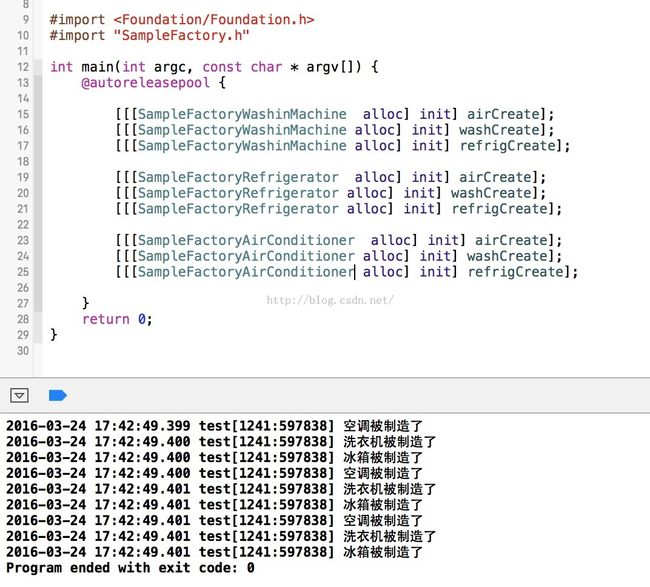iOS的Objective-C的工厂设计模式详解
工厂设计模式,一共有三种:
1. 简单工厂(Sample Factory)
2. 工厂方法 (Factory Method)
3. 抽象工厂 (Abstract Factory)
先来两张图看下
1. 简单工厂 (Sample Factory)
定义一个协议,创建几个遵守该协议的实现类,实现类实现自己的功能,和一个工厂类,这个工厂类用来实现业务逻辑,外部调用工厂时,完全不知工厂内部的实现类的实现
代码:
文件:ZRProduct.h协议文件
#import <Foundation/Foundation.h> @protocol ZRProduct <NSObject> @end文件:ZROperator.h 遵守ZRProduct协议,实现相应的方法的声明
#import <Foundation/Foundation.h> #import "ZRProduct.h" @interface ZROperator : NSObject<ZRProduct> @end @interface WashingMachine : NSObject<ZRProduct> @end @interface Refrigerator : NSObject<ZRProduct> @end @interface AirCondition : NSObject<ZRProduct> @end文件:ZROperator.m 遵守ZRProduct协议,实现相应业务的方法实现
#import "ZROperator.h"
@implementation ZROperator
@end
@implementation WashingMachine
- (instancetype)init
{
if(self = [super init]){
NSLog(@"洗衣机被制造了");
}
return self;
}
@end
@implementation Refrigerator
- (instancetype)init
{
if(self = [super init]){
NSLog(@"冰箱被制造了");
}
return self;
}
@end
@implementation AirCondition
- (instancetype)init
{
if(self = [super init]){
NSLog(@"空调被制造了");
}
return self;
}
@end
文件:SampleFactory.h 工厂类,用来对外调用,调用者不需要知道内部是怎么实现的
#import <Foundation/Foundation.h> #import "ZRProduct.h" @interface SampleFactory : NSObject + (id<ZRProduct>)factory:(Class)className; @end文件:SampleFactory.m 工厂类的实现,需要传一个参数,类名
#import "SampleFactory.h"
#import "ZROperator.h"
@implementation SampleFactory
+ (id<ZRProduct>)factory:(Class)className
{
if([className class] == [WashingMachine class]){
return [[WashingMachine alloc] init];
} else if([className class] == [Refrigerator class]){
return [[Refrigerator alloc] init];
} else if([className class] == [AirCondition class]){
return [[AirCondition alloc] init];
} else {
return nil;
}
}
@end
调用及结果:
2.工厂方法 (Factory Method)
定义一个工厂协议,一个产品协议,多个遵守该协议的实现类,和多个工厂实现类,要求遵守工厂协议,产品协议定义一些共有方法,有产品实现类来实现,工厂协议定义产品协议,所以工厂实现类,实现每个产品实现类的业务
代码:
文件:ZRFactory.h 工厂协议
#import <Foundation/Foundation.h> #import "ZRProduct.h" @protocol ZRFactory <NSObject> - (id<ZRProduct>)create; @end文件:ZRProduct.h 产品协议
#import <Foundation/Foundation.h> @protocol ZRProduct <NSObject> @end文件:ZROperator.h 产品协议实现类头文件
#import <Foundation/Foundation.h> #import "ZRProduct.h" @interface ZROperator : NSObject<ZRProduct> @end @interface WashingMachine : NSObject<ZRProduct> @end @interface Refrigerator : NSObject<ZRProduct> @end @interface AirCondition : NSObject<ZRProduct> @end文件:ZROperator.m 产品实现类实现文件
#import "ZROperator.h"
@implementation ZROperator
@end
@implementation WashingMachine
- (instancetype)init
{
if(self = [super init]){
NSLog(@"洗衣机被制造了");
}
return self;
}
@end
@implementation Refrigerator
- (instancetype)init
{
if(self = [super init]){
NSLog(@"冰箱被制造了");
}
return self;
}
@end
@implementation AirCondition
- (instancetype)init
{
if(self = [super init]){
NSLog(@"空调被制造了");
}
return self;
}
@end文件:SampleFactory.h 实现工厂类头文件
#import <Foundation/Foundation.h> #import "ZRFactory.h" @interface SampleFactory : NSObject @end @interface SampleFactoryWashinMachine : NSObject<ZRFactory> @end @interface SampleFactoryRefrigerator : NSObject<ZRFactory> @end @interface SampleFactoryAirConditioner : NSObject<ZRFactory> @end文件:SampleFactory.m 实现工厂类实现文件,会实现每个工厂方法,当然OC有可选,有必选的
#import "SampleFactory.h"
#import "ZROperator.h"
@implementation SampleFactory
@end
@implementation SampleFactoryWashinMachine
//实现工厂协议的方法,就是调用产品实现类的逻辑
- (id<ZRProduct>)create
{
return [[WashingMachine alloc] init];
}
@end
@implementation SampleFactoryRefrigerator
- (id<ZRProduct>)create
{
return [[Refrigerator alloc] init];
}
@end
@implementation SampleFactoryAirConditioner
- (id<ZRProduct>)create
{
return [[AirCondition alloc] init];
}
@end调用及结果
3.抽象工厂 (Abstract Factory)
定义多个产品协议,创建多个产品实现类遵守产品协议,定义一个工厂协议,包含多个产品协议的定义方法,创建多个工厂实现类遵守工厂协议,实现工厂协议指定的方法
代码:
文件:ZRProduct.h 产品协议类,多个
#import <Foundation/Foundation.h> @protocol ZRProduct <NSObject> @end @protocol WashingMachineProtocol <NSObject> @end @protocol RefrigeratorProtocol <NSObject> @end @protocol AirConditionerProtocol <NSObject> @end文件:ZROperator.h 产品实现类头文件
#import <Foundation/Foundation.h> #import "ZRProduct.h" @interface ZROperator : NSObject<ZRProduct> @end @interface WashingMachine : NSObject<WashingMachineProtocol> @end @interface Refrigerator : NSObject<RefrigeratorProtocol> @end @interface AirCondition : NSObject<AirConditionerProtocol> @end文件:ZROperator.m 产品实现类实现文件
#import "ZROperator.h"
@implementation ZROperator
@end
@implementation WashingMachine
- (instancetype)init
{
if(self = [super init]){
NSLog(@"洗衣机被制造了");
}
return self;
}
@end
@implementation Refrigerator
- (instancetype)init
{
if(self = [super init]){
NSLog(@"冰箱被制造了");
}
return self;
}
@end
@implementation AirCondition
- (instancetype)init
{
if(self = [super init]){
NSLog(@"空调被制造了");
}
return self;
}
@end
文件:ZRFactory.h 工厂协议文件
#import <Foundation/Foundation.h> #import "ZRProduct.h" @protocol ZRFactory <NSObject> - (id<WashingMachineProtocol>)washCreate; - (id<AirConditionerProtocol>)airCreate; - (id<RefrigeratorProtocol>)refrigCreate; @end
文件:SampleFactory.h 工厂实现类头文件
#import <Foundation/Foundation.h> #import "ZRFactory.h" @interface SampleFactory : NSObject @end @interface SampleFactoryWashinMachine : NSObject<ZRFactory> @end @interface SampleFactoryRefrigerator : NSObject<ZRFactory> @end @interface SampleFactoryAirConditioner : NSObject<ZRFactory> @end文件:SampleFactory.m 工厂实现类源文件
#import "SampleFactory.h"
#import "ZROperator.h"
@implementation SampleFactory
@end
@implementation SampleFactoryWashinMachine
//实现抽象工厂的方法,就是间接的调用了产品实现类的方法
- (id<WashingMachineProtocol>)washCreate
{
return [[WashingMachine alloc] init];
}
- (id<RefrigeratorProtocol>)refrigCreate
{
return [[Refrigerator alloc] init];
}
- (id<AirConditionerProtocol>)airCreate
{
return [[AirCondition alloc] init];
}
@end
@implementation SampleFactoryRefrigerator
- (id<WashingMachineProtocol>)washCreate
{
return [[WashingMachine alloc] init];
}
- (id<RefrigeratorProtocol>)refrigCreate
{
return [[Refrigerator alloc] init];
}
- (id<AirConditionerProtocol>)airCreate
{
return [[AirCondition alloc] init];
}
@end
@implementation SampleFactoryAirConditioner
- (id<WashingMachineProtocol>)washCreate
{
return [[WashingMachine alloc] init];
}
- (id<RefrigeratorProtocol>)refrigCreate
{
return [[Refrigerator alloc] init];
}
- (id<AirConditionerProtocol>)airCreate
{
return [[AirCondition alloc] init];
}
@end运行及结果:
如果有说的不对之处,请大师指点!!!~~~谢谢!![]()
综上所述:工厂的三种模式
| 优点 | 缺点 | |
| 简单工厂 | 简单工厂的核心类就是SampleFactory, 负责处理业务逻辑和产品的创建, 我们需要什么类型,什么产品, 只需要给一个 产品名称,简单工厂就能 产品的处理工作和创建 |
1.当新增加一个产品时,需要修改工厂类, 当有很多产品时,那代码量就特别多, 不易于维护 2.当工厂类出现问题,所有产品停止工作 |
| 工厂方法 | 工厂方法,定义一个产品协议,多个遵守该协议的类, 一个工厂协议,多个遵守该协议的实现类, 不同的工厂类实现不同的业务,当某一个 工厂类出现问题,其他的工厂类不受影响 当新增加产品时,不修改其他工厂的代码, 而是新添加一个工厂实现 |
当产品有几个大分类,这几个大分类下又 有许多小分类产品,如果小分类产品一旦 很多,就会造成类爆炸 |
| 抽象工厂 | 抽象工厂,定义几个大分类产品协议, 有多个遵守该协议的实现类, 每个小分类产品遵守自己的大分类协议, 定义一个工厂协议,里面顶一个一些产品 方法,创建大分类的工厂实现类,遵守工厂 协议,实现工厂协议里的方法,在协议里的方法 处理业务逻辑,这个业务逻辑就在产品类里实现 而工厂协议方法里,只负责调用产品实现类已经 实现好的方法 |


